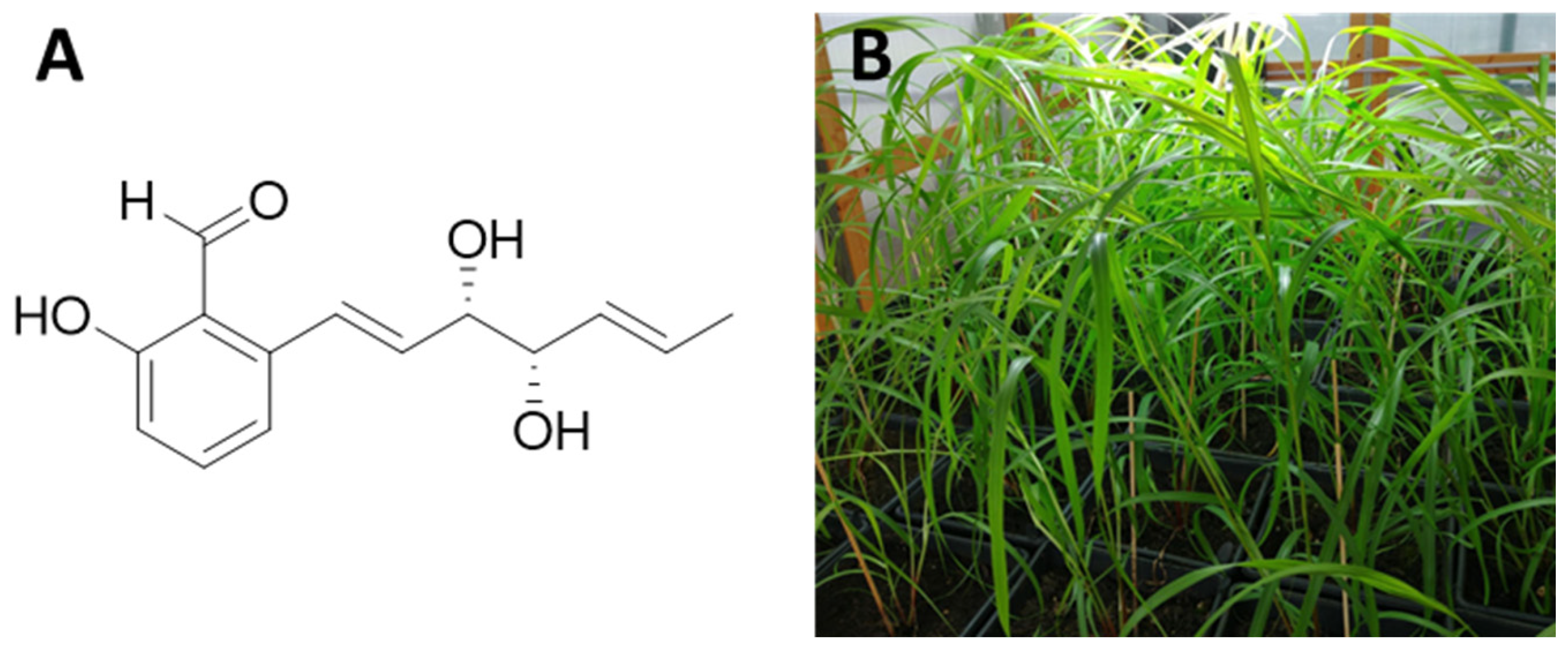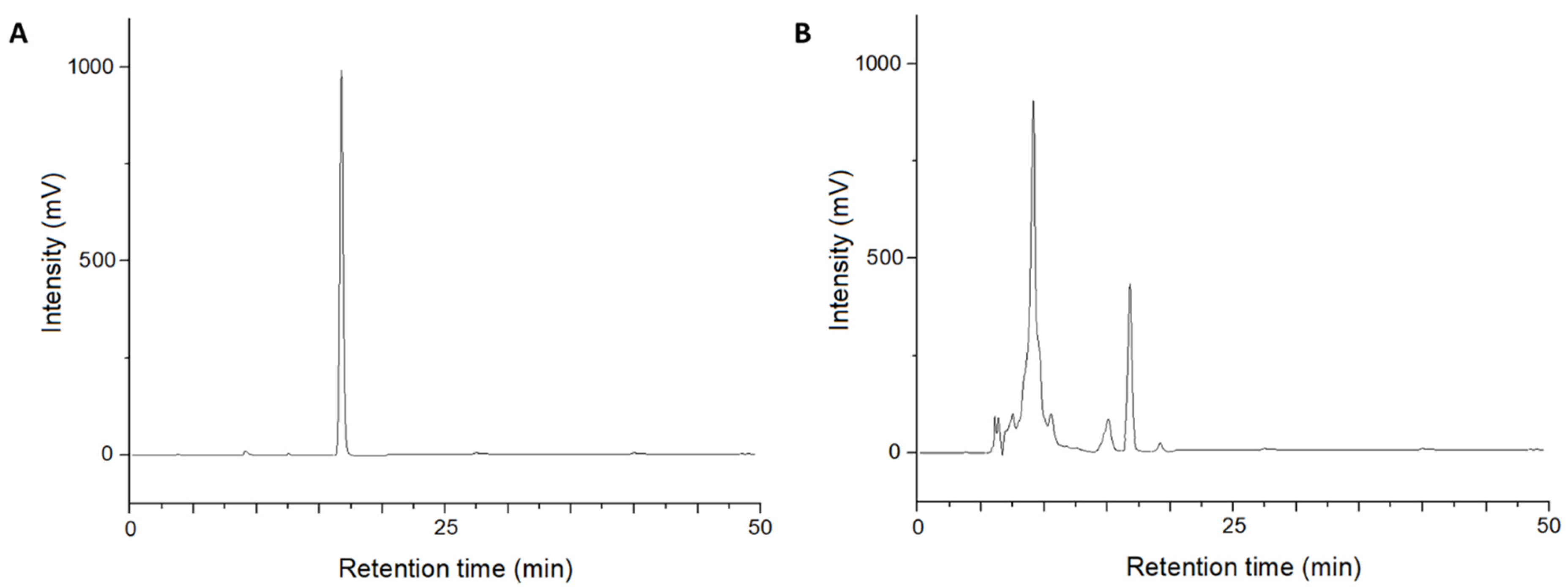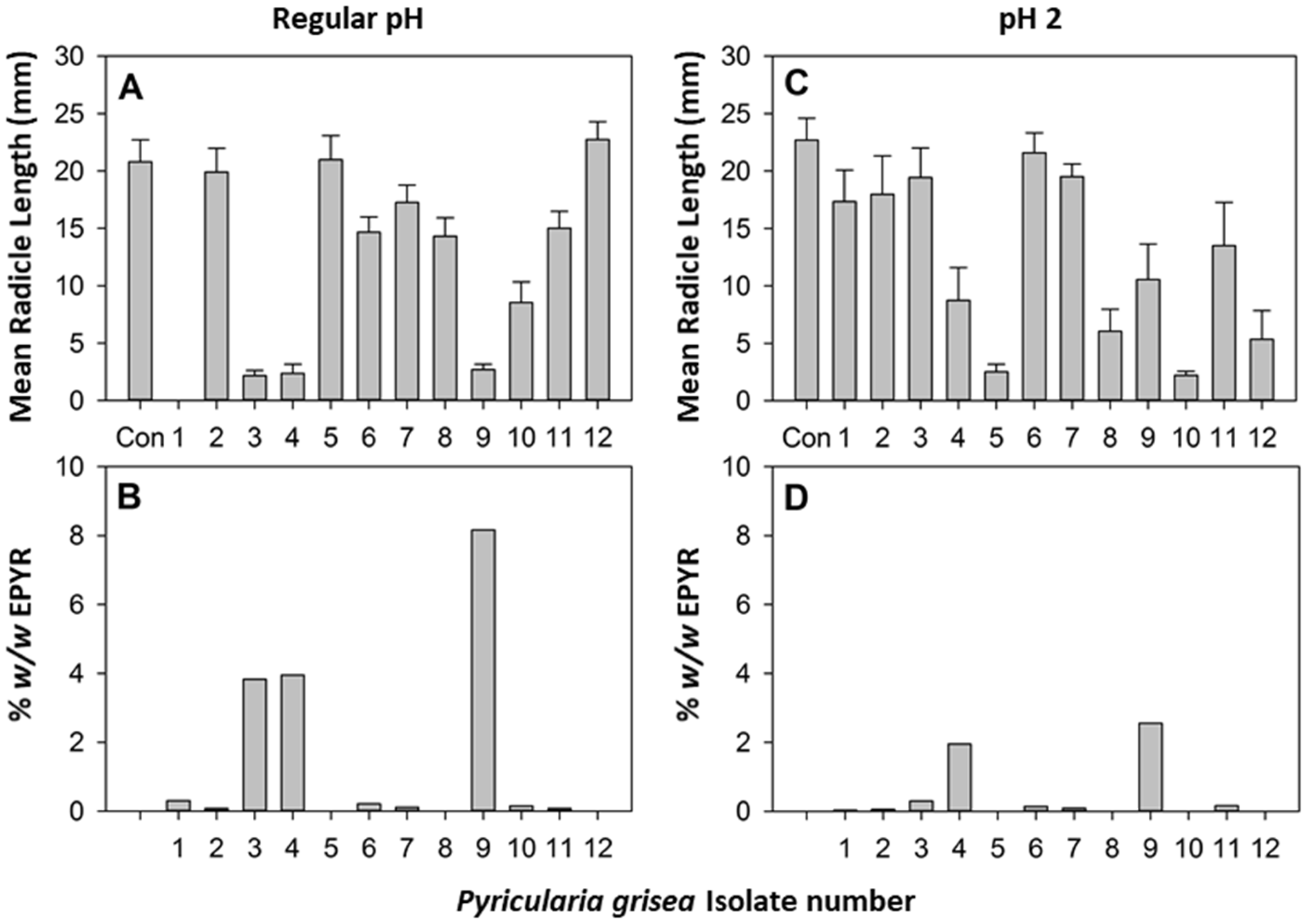Production of (10S,11S)-(—)-epi-Pyriculol and Its HPLC Quantification in Liquid Cultures of Pyricularia grisea, a Potential Mycoherbicide for the Control of Buffelgrass (Cenchrus ciliaris)
Abstract
1. Introduction
2. Materials and Methods
2.1. General Experimental Procedures
2.2. Pyricularia grisea Isolates
2.3. Production and Extraction of Liquid Cultures
2.4. Isolation and Identification of (10S,11S)-(—)-epi-Pyriculol
2.5. HPLC System and Quantification of (10S,11S)-(—)-epi-Pyriculol
2.6. Coleoptile and Radicle Elongation Bioassay
3. Results and Discussion
4. Conclusions
Supplementary Materials
Author Contributions
Funding
Institutional Review Board Statement
Informed Consent Statement
Data Availability Statement
Acknowledgments
Conflicts of Interest
References
- Cimmino, A.; Masi, M.; Evidente, M.; Superchi, S.; Evidente, A. Fungal phytotoxins with potential herbicidal activity: Chemical and biological characterization. Nat. Prod. Rep. 2015, 32, 1629–1653. [Google Scholar] [CrossRef] [PubMed]
- Macías, F.A.; Molinillo, J.M.G.; Galindo, J.C.G.; Varela, R.M.; Simonet, A.M.; Castellano, D. The use of allelopathic studies in the search for natural herbicides. J. Crop Prod. 2001, 4, 237–255. [Google Scholar] [CrossRef]
- Varejão, E.V.; Demuner, A.J.; Barbosa, L.C.; Barreto, R.W. The search for new natural herbicides–Strategic approaches for discovering fungal phytotoxins. Crop Prot. 2013, 48, 41–50. [Google Scholar] [CrossRef]
- Colmenares, A.J.; Aleu, J.; Durán-Patrón, R.; Collado, I.G.; Hernández-Galán, R. The putative role of botrydial and related metabolites in the infection mechanism of Botrytis cinerea. J. Chem. Ecol. 2002, 28, 997–1005. [Google Scholar] [CrossRef]
- Motoyama, T. Secondary metabolites of the rice blast fungus Pyricularia oryzae: Biosynthesis and biological function. Int. J. Mol. Sci. 2020, 21, 8698. [Google Scholar] [CrossRef]
- Masi, M.; Zorrilla, J.G.; Meyer, S. Bioactive metabolite production in the genus Pyrenophora (Pleosporaceae, Pleosporales). Toxins 2022, 14, 588. [Google Scholar] [CrossRef]
- Nukina, M.; Sassa, T.; Ikeda, M.; Umezawa, T.; Tasaki, H. Pyriculariol, a new phytotoxic metabolite of Pyricularia oryzae Cavara. Agric. Biol. Chem. 1981, 45, 2161–2162. [Google Scholar] [CrossRef]
- Nukina, M. Terrestric acid as a phytotoxic metabolite from Pyricularia oryzae Cavara. Agric. Biol. Chem. 1988, 52, 2357–2358. [Google Scholar] [CrossRef]
- Kono, Y.; Sekido, S.; Yamaguchi, I.; Kondo, H.; Suzuki, Y.; Neto, G.C.; Sakurai, A.; Yaegashi, H. Structures of two novel pyriculol-related compounds and identification of naturally produced epipyriculol from Pyricularia oryzae. Agric. Biol. Chem. 1991, 55, 2785–2791. [Google Scholar] [CrossRef]
- Sanmathi Kumar, R.P.; Shanthala, L.; Anilkumar, T.B.; Sudharshana, L. Phytotoxins from Pyricularia grisea and their effect on finger millet. J. Plant Biochem. Biotechnol. 2006, 15, 63–66. [Google Scholar] [CrossRef]
- Masi, M.; Meyer, S.; Górecki, M.; Mandoli, A.; Di Bari, L.; Pescitelli, G.; Cimmino, A.; Cristofaro, M.; Clement, S.; Evidente, A. Pyriculins A and B, two monosubstituted hex-4-ene-2,3-diols and other phytotoxic metabolites produced by Pyricularia grisea isolated from buffelgrass (Cenchrus ciliaris). Chirality 2017, 29, 726–736. [Google Scholar] [CrossRef]
- Masi, M.; Santoro, E.; Clement, S.; Meyer, S.; Scafato, P.; Superchi, S.; Evidente, A. Further secondary metabolites produced by the fungus Pyricularia grisea isolated from buffelgrass (Cenchrus ciliaris). Chirality 2020, 32, 1234–1242. [Google Scholar] [CrossRef] [PubMed]
- Marshall, V.M.; Lewis, M.M.; Ostendorf, B. Buffel grass (Cenchrus ciliaris) as an invader and threat to biodiversity in arid environments: A review. J. Arid Environ. 2012, 78, 1–12. [Google Scholar] [CrossRef]
- Masi, M.; Meyer, S.; Clement, S.; Cimmino, A.; Evidente, A. Effect of cultural conditions on the production of radicinin, a specific fungal phytotoxin for buffelgrass (Cenchrus ciliaris) biocontrol, by different Cochliobolus australiensis strains. Nat. Prod. Res. 2019, 35, 99–107. [Google Scholar] [CrossRef] [PubMed]
- Masi, M.; Freda, F.; Sangermano, F.; Calabrò, V.; Cimmino, A.; Cristofaro, M.; Meyer, S.; Evidente, A. Radicinin, a fungal phytotoxin as a target-specific bioherbicide for invasive buffelgrass (Cenchrus ciliaris) control. Molecules 2019, 24, 1086. [Google Scholar] [CrossRef] [PubMed]
- Soriano, G.; Siciliano, A.; Fernández-Aparicio, M.; Cala Peralta, A.; Masi, M.; Moreno-Robles, A.; Guida, M.; Cimmino, A. Iridoid glycosides isolated from Bellardia trixago identified as inhibitors of Orobanche cumana radicle growth. Toxins 2022, 14, 559. [Google Scholar] [CrossRef]
- Valle, A.L.; Mello, F.C.C.; Alves-Balvedi, R.P.; Rodrigues, L.P.; Goulart, L.R. Glyphosate detection: Methods, needs and challenges. Environ. Chem. Lett. 2019, 17, 291–317. [Google Scholar] [CrossRef]
- Soto-Cruz, F.J.; Zorrilla, J.G.; Rial, C.; Varela, R.M.; Molinillo, J.M.; Igartuburu, J.M.; Macías, F.A. Allelopathic activity of strigolactones on the germination of parasitic plants and arbuscular mycorrhizal fungi growth. Agronomy 2021, 11, 2174. [Google Scholar] [CrossRef]
- Araniti, F.; Lupini, A.; Sorgonà, A.; Conforti, F.; Marrelli, M.; Statti, G.A.; Menichini, F.; Abenavoli, M.R. Allelopathic potential of Artemisia arborescens: Isolation, identification and quantification of phytotoxic compounds through fractionation-guided bioassays. Nat. Prod. Res. 2013, 27, 880–887. [Google Scholar] [CrossRef]
- Lebrun, M.H.; Dutfoy, F.; Gaudemer, F.; Kunesch, G.; Gaudemer, A. Detection and quantification of the fungal phytotoxin tenuazonic acid produced by Pyricularia oryzae. Phytochemistry 1990, 29, 3777–3783. [Google Scholar] [CrossRef]
- Schoch, C.L.; Seifert, K.A.; Huhndorf, S.; Robert, V.; Spouge, J.L.; Levesque, C.A.; Chen, W.; Fungal Barcoding Consortium; Fungal Barcoding Consortium Author List; Bolchacova, E.; et al. Nuclear ribosomal internal transcribed spacer (ITS) region as a universal DNA barcode marker for Fungi. Proc. Natl. Acad. Sci. USA 2012, 109, 6241–6246. [Google Scholar] [CrossRef] [PubMed]
- López-Díaz, C.; Rahjoo, V.; Sulyok, M.; Ghionna, V.; Martín-Vicente, A.; Capilla, J.; Di Pietro, A.; López-Berges, M.S. Fusaric acid contributes to virulence of Fusarium oxysporum on plant and mammalian hosts. Mol. Plant Pathol. 2018, 19, 440–453. [Google Scholar] [CrossRef]
- Landraud, P.; Chuzeville, S.; Billon-Grande, G.; Poussereau, N.; Bruel, C. Adaptation to pH and role of PacC in the rice blast fungus Magnaporthe oryzae. PLoS ONE 2013, 8, e69236. [Google Scholar] [CrossRef]
- Guidance for Industry, Bioanalytical Method Validation, U.S. Department of Health and Human Services, Food and Drug Administration, Center for Drug Evaluation and Research (CDER), Center for Veterinary Medicine (CMV). May 2018. Available online: https://www.fda.gov/downloads/drugs/guidances/ucm070107.pdf (accessed on 8 February 2023).
- Meesters, R.; Voswinkel, S. Bioanalytical method development and validation: From the USFDA 2001 to the USFDA 2018 guidance for industry. J Appl. Bioanal. 2018, 4, 67–73. [Google Scholar] [CrossRef]
- Armbruster, D.A.; Pry, T. Limit of blank, limit of detection and limit of quantitation. Clin. Biochem. Rev. 2008, 29, S49. [Google Scholar] [PubMed]
- Wipfler, R.; McCormick, S.P.; Proctor, R.H.; Teresi, J.M.; Hao, G.; Ward, T.J.; Alexander, N.; Vaughan, M.M. Synergistic phytotoxic effects of culmorin and trichothecene mycotoxins. Toxins 2019, 11, 555. [Google Scholar] [CrossRef]
- Masi, M.; Meyer, S.; Cimmino, A.; Clement, S.; Black, B.; Evidente, A. Pyrenophoric acids B and C, two new phytotoxic sesquiterpenoids produced by Pyrenophora semeniperda. J. Agric. Food Chem. 2014, 62, 10304–10311. [Google Scholar] [CrossRef] [PubMed]
- Jmii, G.; Zorrilla, J.G.; Haouala, R. Allelochemicals from Thapsia garganica leaves for Lolium perenne L. control: The magic of mixtures. Chemoecology 2022, 32, 81–87. [Google Scholar] [CrossRef]
- Moeini, A.; Masi, M.; Zonno, M.C.; Boari, A.; Cimmino, A.; Tarallo, O.; Vurro, M.; Evidente, A. Encapsulation of inuloxin A, a plant germacrane sesquiterpene with potential herbicidal activity, in β-cyclodextrins. Org. Biomol. Chem. 2019, 17, 2508–2515. [Google Scholar] [CrossRef]
- Mejías, F.J.; Carrasco, Á.; Durán, A.G.; Molinillo, J.M.; Macías, F.A.; Chinchilla, N. On the formulation of disulfide herbicides based on aminophenoxazinones. Polymeric nanoparticle formulation and cyclodextrin complexation to combat crop yield losses. Pest Man. Sci. 2023. [Google Scholar] [CrossRef]



| Isolate Number | P. grisea Isolate | Lyophilized Culture Filtrate Weight (g) | Lyophilized Mycelial Weight (g) | pH of the Culture Filtrate | EtOAc Organic Extract at Regular pH (mg) | EtOAc Organic Extract at pH 2 (mg) |
|---|---|---|---|---|---|---|
| 1 | CB 5B2 | 1.73 | 0.37 | 8 | 3.61 | 7.22 |
| 2 | CB 5C2 | 1.36 | 0.37 | 8 | 7.56 | 15.74 |
| 3 | MR 4D1 | 1.57 | 0.42 | 9 | 6.00 | 10.12 |
| 4 | SNM 2-1A3 | 1.67 | 0.37 | 8 | 12.95 | 14.25 |
| 5 | SNM 2-2A1 | 1.84 | 0.27 | 5 | 5.17 | 21.67 |
| 6 | SNM 2-2A2 | 1.69 | 0.36 | 8 | 5.34 | 14.33 |
| 7 | SNM 3B2 | 1.79 | 0.33 | 8 | 5.19 | 6.75 |
| 8 | SNM 3E2A | 2.12 | 0.21 | 5 | 6.69 | 27.21 |
| 9 | SNM 5A2 | 1.49 | 0.36 | 9 | 16.04 | 14.40 |
| 10 | SNM 5B1 | 2.22 | 0.20 | 5 | 5.23 | 19.57 |
| 11 | SNM 5B2 | 2.04 | 0.29 | 7 | 5.55 | 12.63 |
| 12 | SNM 5D1 | 1.61 | 0.34 | 8 | 5.08 | 19.80 |
| Retention Time (min) | Range (µg) | R2 | Data Points | Limit of Detection (µg) |
|---|---|---|---|---|
| 17.373 | 0.0078–5 | 0.998 | 20 | 0.0078 |
| Isolate Number | P. grisea Isolate | Regular pH | pH 2 | ||
|---|---|---|---|---|---|
| % w/w EPYR in the Organic Extract | Production Yield (mg/L) of EPYR 1 | % w/w EPYR in the Organic Extract | Production Yield (mg/L) of EPYR 1 | ||
| 1 | CB 5B2 | 0.30 | 0.09 ± 0.02 | 0.03 | 0.02 ± 0.01 |
| 2 | CB 5C2 | 0.09 | 0.05 ± 0.01 | 0.06 | 0.07 ± 0.02 |
| 3 | MR 4D1 | 3.83 | 1.83 ± 0.09 | 0.29 | 0.23 ± 0.06 |
| 4 | SNM 2-1A3 | 3.95 | 4.07 ± 0.13 | 1.95 | 2.22 ± 0.09 |
| 5 | SNM 2-2A1 | 0 | 0 | 0 | 0 |
| 6 | SNM 2-2A2 | 0.21 | 0.09 ± 0.02 | 0.14 | 0.16 ± 0.02 |
| 7 | SNM 3B2 | 0.11 | 0.04 ± 0.01 | 0.09 | 0.05 ± 0.01 |
| 8 | SNM 3E2A | 0 | 0 | 0 | 0 |
| 9 | SNM 5A2 | 8.17 | 10.46 ± 0.21 | 2.56 | 2.95 ± 0.08 |
| 10 | SNM 5B1 | 0.15 | 0.06 ± 0.02 | 0 | 0 |
| 11 | SNM 5B2 | 0.09 | 0.03 ± 0.01 | 0.16 | 0.16 ± 0.01 |
| 12 | SNM 5D1 | 0 | 0 | 0 | 0 |
Disclaimer/Publisher’s Note: The statements, opinions and data contained in all publications are solely those of the individual author(s) and contributor(s) and not of MDPI and/or the editor(s). MDPI and/or the editor(s) disclaim responsibility for any injury to people or property resulting from any ideas, methods, instructions or products referred to in the content. |
© 2023 by the authors. Licensee MDPI, Basel, Switzerland. This article is an open access article distributed under the terms and conditions of the Creative Commons Attribution (CC BY) license (https://creativecommons.org/licenses/by/4.0/).
Share and Cite
Zorrilla, J.G.; Masi, M.; Clement, S.; Cimmino, A.; Meyer, S. Production of (10S,11S)-(—)-epi-Pyriculol and Its HPLC Quantification in Liquid Cultures of Pyricularia grisea, a Potential Mycoherbicide for the Control of Buffelgrass (Cenchrus ciliaris). J. Fungi 2023, 9, 316. https://doi.org/10.3390/jof9030316
Zorrilla JG, Masi M, Clement S, Cimmino A, Meyer S. Production of (10S,11S)-(—)-epi-Pyriculol and Its HPLC Quantification in Liquid Cultures of Pyricularia grisea, a Potential Mycoherbicide for the Control of Buffelgrass (Cenchrus ciliaris). Journal of Fungi. 2023; 9(3):316. https://doi.org/10.3390/jof9030316
Chicago/Turabian StyleZorrilla, Jesús G., Marco Masi, Suzette Clement, Alessio Cimmino, and Susan Meyer. 2023. "Production of (10S,11S)-(—)-epi-Pyriculol and Its HPLC Quantification in Liquid Cultures of Pyricularia grisea, a Potential Mycoherbicide for the Control of Buffelgrass (Cenchrus ciliaris)" Journal of Fungi 9, no. 3: 316. https://doi.org/10.3390/jof9030316
APA StyleZorrilla, J. G., Masi, M., Clement, S., Cimmino, A., & Meyer, S. (2023). Production of (10S,11S)-(—)-epi-Pyriculol and Its HPLC Quantification in Liquid Cultures of Pyricularia grisea, a Potential Mycoherbicide for the Control of Buffelgrass (Cenchrus ciliaris). Journal of Fungi, 9(3), 316. https://doi.org/10.3390/jof9030316









